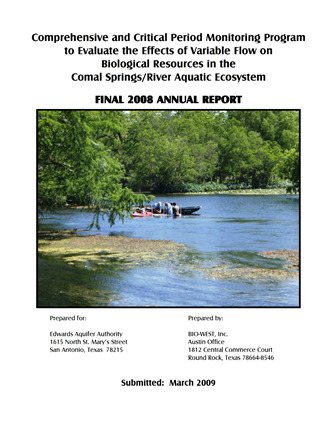Comprehensive and Critical Period Monitoring Program to Evaluate the Effects of Variable Flow on Biological Resources in the Comal Springs/River Aquatic Ecosystem Final 2008 Annual Report

| Summary |
|
The purpose of this report is to document the results of all aquatic ecosystem monitoring conducted in 2008 at Comal Springs located in New Braunfels, Texas. The monitoring and report preparation was performed by BIO-WEST, Inc. Pflugerville, Texas. [Excerpted from the Executive Summary] Filamentous algae covered enough area in the Old Channel Reach in 2008 to justify sampling for fountain darters within it. This is important to note as conditions have not allowed this for several years. Filamentous algae have consistently had the highest density of fountain darters of any vegetation type…. Normalized population estimates [of fountain darters] for spring 2008 were the highest recorded since 2003. As in previous years, length-frequency distribution data reflected a spring reproductive peak for fountain darters…. Spring Run 1 and Spring Run 3 yielded almost twice the number of salamanders in 2008 compared to 2007. On the contrary, Spring Island salamander counts were considerably less in 2008. No salamander observations at the Spring Island Spring Run for the third straight sampling session is likely because of the removal of fist-size rocks (preferred habitat) at this site…. Similar to 2007, species of the genus Stygobromus and Lirceolus continued to be most abundant at all sites. Peck’s cave amphipod (Stygobromus pecki) was the dominant amphipod at all sites. There were substantially more Comal Springs riffle beetles (Heterelmis comalensis) collected in 2008 than in 2007…. Near average flows in the Comal River in 2008 continued to maintain fountain darter populations in this unique springs system. Non-native and native vegetation continued to compete at several reaches, but with the exception of Ludwigia at Landa Lake, surface areas were similar to 2007. The presence of bryophytes in some of the reaches will continue to harbor large populations of fountain darters. If the central Texas drought continues into 2009, resulting flow decreases may trigger low-flow Critical Period sampling events. These events, although undesirable for the public and environment should provide much needed information on biotic responses to more extreme conditions. |
Search for Documents
Advance Search
Explore EAA's Scientific Reports
- All Reports
- Overview Studies
- Modeling
- Hydrology and Hydrogeology
- History
- Groundwater Recharge, Recharge Zone
- Groundwater Movement
- Geomorphology and Caves
- Weather Modification
- Geology
- Water Use and Conservation
- Geochemistry
- Water Resources Planning and Management
- Floods and Drought
- Water Quality
- Climatology
- Surface Water / Groundwater Relationship
- Biology
- Springs, Groundwater Discharge
- Archaeology
- RZ Protection
- Aquifer Levels
- Remote Sensing
- Precipitation
